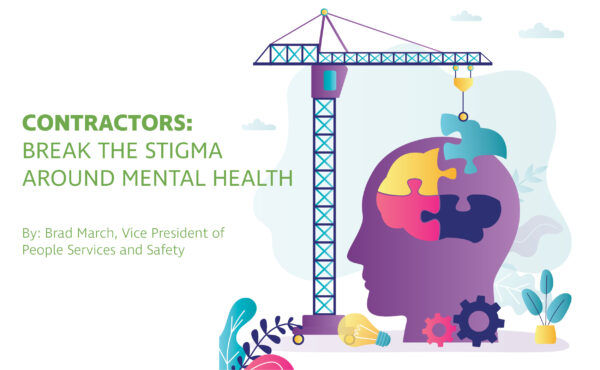Limited budgets. Tough deadlines. Demanding clients. Complex building systems. Long days. Hard work. Time and time again our operations, preconstruction and business services teams answer the call of duty to build what matters. All the while juggling other demands outside of work. This can take its toll on our physical — and mental — health.
While the focus on physical safety is paramount to Saunders, the mental health of our workers can be overlooked. However, there is a growing recognition of the importance of mental health initiatives in the construction industry and at Saunders. Addressing mental health concerns not only enhance the overall wellbeing of our teammates, but also improve physical safety, productivity and overall job satisfaction.
Some industries have higher suicide rates than others and are more impacted. The industries most impacted include most male-dominated industries like construction, mining, and oil and gas. Statistics reveal the severity of the mental health crisis in the construction sector. According to the Centers for Disease Control, construction has one of the highest suicide rate of all industries, at 43.6 suicides per 100,000 workers*. Additionally, the studies show workers in the construction field experience higher rates of anxiety, depression and addiction compared to other industries. This information underscores the urgent need for mental health initiatives to support workers in this industry.
“Mental health programs and policies help ensure there is a standard for the long term and not just at the whim of a couple of passionate workers,” said Dr. Sally Spencer-Thomas, clinical psychologist and mental health advocate. “Mental health programs can include general awareness training, manager training, peer support programs and mental health resource benefits. Organizations that have these policies and programs should then make sure that they are well socialized throughout the workforce.”
Partnered with Spencer-Thomas, Saunders Construction is implementing a mental health initiative intertwined with and at the same level as our physical health safety program.
Downstream practices help organizations make sure that the mental health resources that they are offering their workers understand how to help people experiencing suicide intensity, how to respond in a crisis while at the same time upholding workers’ dignity and providing collaboration in their recovery.
Recently, United Suicide Survivors International, with the support of the American Foundation for Suicide Prevention and the Workplace Suicide Prevention Committee has developed a new H.O.P.E. certification. H.O.P.E. stands for “Helping Our People Elevate through tough times.” Saunders Construction is one of 10 organizations that was selected to pilot this 12-month program in Colorado. This program recently completed its inaugural pilot in the state of New York with much success in the construction industry.
The benefits of mental health initiatives include:
- Enhanced well-being. Prioritizing mental health initiatives helps create a supportive and inclusive work environment. With customized resources and tools, we all can better manage stress, anxiety and depression. This leads to improved overall well-being, job satisfaction and reduced burnout.
- Increased productivity. Fatigue, lack of focus, and decreased motivation can lead to errors, accidents and increased absenteeism. Implementing mental health initiatives helps identify and address these issues, leading to increased productivity and efficiency in our daily work.
- Improved safety. Mental health challenges can impair decisionmaking abilities and concentration, which can compromise physical safety on construction sites. By promoting mental wellbeing, we all are better equipped to recognize and mitigate potential risks, leading to a safer work environment.
- Reduced costs. Mental health challenges can result in increased health care costs, absenteeism and high staff turnover rates. Taking proactive steps can help avoid productivity losses and the expenses associated with recruiting and training new employees.
“No matter who you are or what your job responsibilities are, we want to create a culture of care for all. We want everyone to develop the skills to notice the signs when someone may need a little extra support,” said Ame Muniz, director of learning and development at Saunders Construction.
*Per McIntosh WL, Spies E, Stone DM, Lokey CN, Trudeau AT, Bartholow B. Suicide Rates by Occupational Group — 17 States, 2012. MMWR Morb Mortal Wkly Rep 2016;65:641–645. DOI: http://dx.doi.org/10.15585/mmwr.mm6525a1external icon. This rate includes males only. Rates were not calculated where the decedents (i.e., female) were fewer than 20 because those estimates might be unreliable.
Media Contact
Teena Bergstand
Vice President of Market Strategies and Communication
(303) 699-9000
m.inquiries@saundersinc.com
